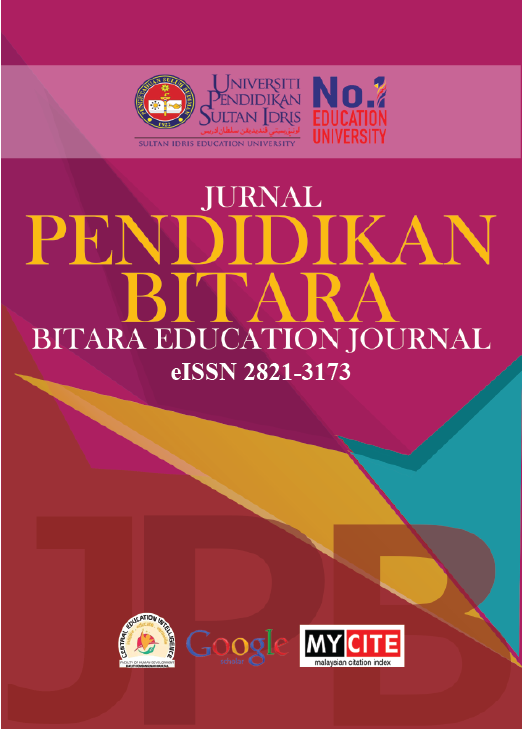Pedagogical approaches using Neuro-Linguistic Programming (NLP) Strategies from Perspective of NLP-Trained teachers
DOI:
https://doi.org/10.37134/bitara.vol16.2.10.2023Keywords:
NLP, secondary school teachers, pedagogyAbstract
The purpose of this study is to explore how Neuro Linguistic Programming (NLP) strategies applied by NLP-trained teachers as their pedagogical approaches in teaching and learning. A qualitative research was conducted among secondary school teachers in Malaysia. A total of 7 interviewees were selected. Content analysis and critical discourse analysis on analysing three sources of data collection have been carefully applied. The teachers are NLP practitioners who have been certified by the National Federation of Neuro-Linguistic Programming (NFNLP) and NLP Malaysia. This study identifies strategies of NLP that have been applied in the teaching and learning process. The strategies include ‘building rapport’, ‘representational system’, ‘logical level’, ‘Milton Models’, ‘metaphors’ and ‘anchoring’. The findings indicate that NLP is a viable means of teaching and learning practices in the classroom, but it needs flexibility due to the obstacles faced in its practices. This study identifies that NLP is a great tool in empowering teaching skills among teachers. It is also a medium to enhance the teaching and learning process. Therefore, this study proposes more thorough research on the challenges and practices of NLP on teaching and learning in the future.
Downloads
References
Badley, Ken and Hollabaugh, Jaliene, "Metaphors for Teaching and Learning" (2012). Faculty Publications - School of Education. Paper 49.
Bandler R., & Grinder, J. (1976). The structure of magic II. Palo Alto, CA: Science and Behavior Books, Inc.
Bandler, R. & Grinder, J. (1979). Frogs into princes.Moab, UT: Real People Press.
Bandler, R. & Grinder, J. (1982). Reframing: neuro-linguistic programming and the transformation of meaning. Moab, Utah: Real People Press,
Baxter, P., & Jack, S. (2008). Qualitative case study methodology: Study design and implementation for novice researchers. The qualitative report, 13(4), 544-559.
Craft, A. (2001). Neuro-linguistic programming and learning theory. The Curriculum Journal, 12(1), 125-136
Creswell, J. W. (2013). Research design: Qualitative, quantitative, and mixed methods approaches. Sage publications.
Chomsky, N. (1972). Language and mind (p. 194). New York: Harcourt Brace Jovanovich.
Dolnick, K. H. (2006). Neuro-Linguistic applications to classroom management: reach them to teach them. ProQuest.
Glass, G.V, Cahen, L.S, Smith, M.L & Filby, N.N (1982), School class size: Reasearch and Policy
Groton, R. A. (1983). School administration and supervision leadership: Challenges and opportunities. USA, Brown publishers limited. Retrieved March 4, 2014, from www.alibris.com/search/books/isbn/9780697062468
Hallowell, E. M., & Ratey, J. J. (1996). Attention Deficit Disorder: Edward M. Hallowell and John J. Ratey. Fourth Estate.
Pagano, G. (2007). NLP and teenage boredom-dreaming of a class. Humanising Language Teaching, 9(6). Retrieved November 24, 2014, from www.hltmag.co.uk/sep02/ martnov027.rtf
Pilgrims. (2005) Teacher Training- NLP for Teachers www.pilgrims.co.uk/teachers/info/tnp.asp
Schanzenbach, D. W. (2014). Does class size matter. Policy Briefs, National Education Policy Center, School of Education, University of Colorado, Boulder.
Stemmer, B., & Whitaker, H. A. (1998). Handbook of neurolinguistics. Elsevier.
Thornbury, S. (2001). The unbearable lightness of EFL. ELT Journal, 55(4), 391-402. WA: Michael Grinder & Associates History of NLP. (n. d.) Retrieved July 27, 2005 from http://www.nlp3.com.uk/history/history.htm.
Tosey, P., & Mathison, J. (2003). Neuro-linguistic programming and learning theory: A response. The Curriculum Journal, 14(3), 371-388.
Tosey, P & Mathison, J. (2005). Mapping transformative learning: The potential of neuro- linguistic programming. Journal of Transformative Education, (2005), 3 (2). 140-157.
Tosey, P. (2006). Bateson’s levels of learning: A framework for transformative learning? Paper presented at Universities‟ Forum for Human Resource Development Conference, University of Tilburg, May 2006. Retrieved April 19, 2014, from http://epubs.surrey.ac.uk/cgi/viewcontent.cgi?article=1016 &context=humresmgmt
Tosey, P., & Mathison, J. (2006). Introducing neuro-linguistic programming. Centre for Management Learning & Development, School of Management, University of Surrey.
Tosey, P. (2008). `It‟s a living thing‟: A neuro-linguistic programming perspective on essay writing. Humanising Language Teaching, 10(5). Retrieved April 5, 2014, from http://www.hltmag.co.uk/oct08/mart02.htm
Yontef, G. (1993). Gestalt Therapy: An Introduction. Retrieved July-15-2005 From: http://www.Gestalt.Org/Yontef.Htm.
Downloads
Published
Issue
Section
License
Copyright (c) 2023 Nik Muhammad Hanis Nek Rakami, Muhammad Ihsan Rokeman

This work is licensed under a Creative Commons Attribution-NonCommercial-ShareAlike 4.0 International License.





